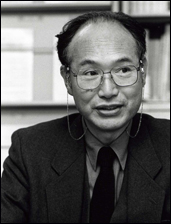Hirotsugu Ueshima
Year: May 1st, 2005
Location: Washington, DC
Interviewed by: Blackburn, Henry
Abstract
This is a first interview to set up the picture of Japanese contributions to CVD epidemiology about which we have between us a good general idea. Here we have requested Dr. Ueshima to write up a summary and to find some photographs if possible. We will seek further information from Iso, Toshima, and Komachi.
(Subsequently, Ueshima provided summaries of all the Japanese studies and centers involved in CVD epidemiology and prevention research, and biographies of the leaders, including studies at Kurume, Hirosaki, Hisayama, Ohasama, Osaka, Shige, Sobatsu, Tanno, and the Seven Countries and NIHONSAN studies.) (HB)
Quotes
HB: From the beginning it seems to have started in Kyushu, right? That would have been Kimura and Toshima. Then came Komachi. And what’s the next wave of centers?
HU: Maybe one of ours but we are a [relatively] new one.
HB: No, you were very early involved and you have moved the field forward particularly. We are interested in the main movements in Japan and what you regard as the main concepts, questions, and contributions. Certainly the definition of stroke types and the relative importance of salt and protein and all these things, including the mortality trends that are still an interesting puzzle.
HU: Dr. Sasaki was one of the pioneers. But his department has disappeared.
HB: We have to know that. About Hatano. Did he do much when he came back to Japan from WHO?
HU: In my country it was considered that he worked in WHO, definitely. [Intimating NOT doing much in Japan]
HB: What is going on in Japan now in this area? Is epidemioology growing?
HU: Growing, yes. And in new areas. One of the new areas is with Dr. Iso, he is one of the excellent new people.
HB: He is working in Tsukuba or Osaka or both?
HU: Most of the work is based on Osaka, so he is using those Osaka data.
HB: And he has young people working with him?
HU: Yes. Maybe he will be one of the top leaders in Japan in the future.
HB: Do you collaborate with him or correspond with him?
HU: Yes, I recently collected many cohort data based on a big grant including Kyushu to Osaka and so we now have a plan to make individual-based meta-analysis using the past and prospective cohorts. And this movement and this year’s government gave us a big grant (not compared to American-sized, but for Japan), to get all existing cohort data scoring in my department and to get data which can be applied to policy making. It’s a new movement.
HB: And who are the people in government who are interested in that? Is it the national institute?
HU: National Institute and also the government in Tokyo.
HB: There is still an active National Cardiovascular Institute, with who directing?
HU: Yes, and one of my junior colleagues moved to replace my position. Doctor Okyama moved to the National Cardiovascular Center after being an associate professor for five years in my department. So now it’s maybe Osaka that is growing. But the minus factor is that Dr. Okyama left for Osaka so that we are waiting for new efforts and support for epidemiology from the National Cardiovascular Center. But Dr. Okyama will .. more than Tominaga than me so he will be one of the candidates.
HB: There is no senior person, they have all gone.
HU: One new group is in Taho University. Their group measures 24-hour blood pressure monitoring and also do a home blood pressure study and this may contribute to useful guidelines in the International Society of Hypertension.
HB: Has anything developed in the north?
HU: A few populations there and also Dr. Suzuki is at the Institute of Stroke, monitoring the stroke incidence for a long time. I should describe the death trends and I will collect the data as I know most of the key persons.
HB: Can you add what you think are seminal references; not a complete bibliography, but classic papers of the Japanese contributions so we can focus on the ones that you would judge as central contributions. Also it would be nice to add any anecdotes and photographs of field studies or historic photos to make it more interesting. I would like you to look at the web site we are just beginning. It will be up for another 2-3 days. If you look at it you will get an idea what we want to do. I want you to do this right out of your head. Just dictate brief things and give us references and your overview of the primary contributions, the classical papers and studies. I don’t want you to write 100 pages, I’m talking about 10 pages at the most.
HU: Ok, 10 pages;, ok.
HB: Scan some photos and send them to me via email. I’ll give you my email address. Can I have your email or card?
HU: Could you edit my English?
HB: Yes, of course. Thank you very much. I’ll stay in touch with you. There’s a web site and a book we are working on now. Have you met our two young colleagues that are working with us in Minnesota now, Ohira, and Hosawa?
HU: I met them yesterday.
HB: I think they are good people. They are working with Aaron Folsom primarily.
HU: He is staying here and after that he is starting some position in Japan and I will help him.
Full Transcript Access
Full transcripts of interviews may be made available to those engaged with original materials for scholarly studies by contacting us.
